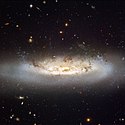NGC 4522
| Galaxie NGC 4522 | |
|---|---|
(c) ESA/Hubble, CC BY 4.0 | |
| Aufnahme des Hubble-Weltraumteleskops | |
| AladinLite | |
| Sternbild | Jungfrau |
| Position Äquinoktium: J2000.0, Epoche: J2000.0 | |
| Rektaszension | 12h 33m 39,7s[1] |
| Deklination | +09° 10′ 30″[1] |
| Erscheinungsbild | |
| Morphologischer Typ | SB(s)cd: / HII[1] |
| Helligkeit (visuell) | 12,1 mag[2] |
| Helligkeit (B-Band) | 12,8 mag[2] |
| Winkelausdehnung | 3,6′ × 1′[2] |
| Positionswinkel | 33°[2] |
| Flächenhelligkeit | 13,3 mag/arcmin²[2] |
| Physikalische Daten | |
| Zugehörigkeit | Virgo-Cluster NGC 4168-Gruppe LGG 285[1][3] |
| Rotverschiebung | 0.007769 ± 0.000003[1] |
| Radialgeschwindigkeit | 2339 ± 1 km/s[1] |
| Hubbledistanz H0 = 73 km/(s • Mpc) | (101 ± 7) · 106 Lj (31,1 ± 2,2) Mpc [1] |
| Geschichte | |
| Entdeckung | John Herschel |
| Entdeckungsdatum | 18. Januar 1828 |
| Katalogbezeichnungen | |
| NGC 4522 • UGC 7711 • PGC 41729 • CGCG 070-168 • MCG +02-32-137 • IRAS 12311+0926 • VCC 1516 • GC 3072 • h 1325 • LDCE 0904 NED177 | |
NGC 4522 ist eine Balken-Spiralgalaxie mit ausgedehnten Sternentstehungsgebieten vom Hubble-Typ SBc im Sternbild Jungfrau auf der Ekliptik. Sie ist schätzungsweise 101 Millionen Lichtjahre von der Milchstraße entfernt und hat einen Durchmesser von etwa 110.000 Lichtjahren.
Die Galaxie bewegt sich mit einer Geschwindigkeit von rund 10 Millionen Kilometer pro Stunde durch das Gas zwischen den Galaxien, so entsteht ein heftiger Wind, der auch das Gas von NGC 4522 mitreißt. Dadurch scheint ihre interstellare Materie in den intergalaktischen Raum zu blasen. Die Astronomen bezeichnen diesen Effekt als „ram pressure stripping“.
Sie wird unter der Katalognummer VVC 1516 als Teil des Virgo-Galaxienhaufens gelistet. Im selben Himmelsareal befinden sich u. a. die Galaxien NGC 4519, IC 3487, IC 3517, IC 3518.
Das Objekt wurde am 18. Januar 1828 von dem britischen Astronomen John Herschel entdeckt.[4]
Weblinks
- SIMBAD Astronomical Database
- GALEX
- The Virgo Cluster Galaxy NGC 4522 : Gas Stripping in Action
- astronews.com: Bild des Tages 29. Juni 2012
Einzelnachweise
Auf dieser Seite verwendete Medien
(c) ESA/Hubble, CC BY 4.0
Hubble's Advanced Camera for Surveys (ACS) allows astronomers to study an interesting and important phenomenon called ram pressure stripping that is so powerful, it is capable of mangling galaxies and even halting their star formation.
NGC 4522 is a spectacular example of a spiral galaxy that is currently being stripped of its gas content. The galaxy is part of the Virgo galaxy cluster and its rapid motion within the cluster results in strong winds across the galaxy as the gas within is left behind. Scientists estimate that the galaxy is moving at more than 10 million kilometres per hour. A number of newly formed star clusters that developed in the stripped gas can be seen in the Hubble image. The stripped spiral galaxy is located some 60 million light-years away from Earth.
Even though it is a still image, Hubble's view of NGC 4522 practically swirls off the page with apparent movement. It highlights the dramatic state of the galaxy with an especially vivid view of the ghostly gas being forced out of it. Bright blue pockets of new star formation can be seen to the right and left of centre.
